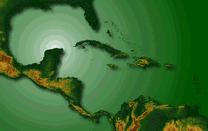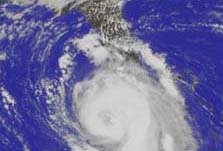New weather detection system for the Caribbean
 The Caribbean will better able to prepare for violent storms and floods caused by the sea, when a long-awaited early warning weather radar system links up across the region over the next four years. The radar system is expected to greatly improve the quality of short-range forecasting, enabling meteorologists to track thunderstorms and other weather disturbances over shorter periods and distances.
The Caribbean will better able to prepare for violent storms and floods caused by the sea, when a long-awaited early warning weather radar system links up across the region over the next four years. The radar system is expected to greatly improve the quality of short-range forecasting, enabling meteorologists to track thunderstorms and other weather disturbances over shorter periods and distances.
The network, to stretch from French Guiana in the South to the Dominican Republic in the north, is being funded by the European Commission, the executive arm of the European Union. “This system will promote greater cooperation and sharing of information in the region and should thereby help reduce the amount of damage suffered by the people of the Caribbean from natural disasters,” the European Commission (EC) Delegation in Guyana said.The EC is funding the installation of four radar weather stations in Guyana, Barbados, Trinidad and Belize to the tune of 13.2 million Euros. The new network will replace an obsolete network of radar which once stretched from Cuba to Trinidad. When construction is finished, the radar stations will be linked by satellite to other stations in France’s Overseas Departments - French Guiana, Martinique and Guadeloupe - as well as other stations in Jamaica and the Dominican Republic.The Eastern Caribbean islands are to be linked to the system by submarine fibre optic cables to form the Regional Weather Radar Early Warning System in the Caribbean through which radar images and data are to be exchanged regularly.The four station countries are responsible for providing land, infrastructure, services and local technical support to operate and maintain the radar stations after they are built.The Caribbean Community’s Secretary General, Edwin Carrington, who also heads the Cariforum group of nations within African, Caribbean and Pacific bloc, said the early warning weather stations would help reverse an age-old trend of the region being devastated by hurricanes and floods caused by the Atlantic Ocean.“These severe adverse weather-effects negatively impact on the economic and social development of the countries of the region. The cost in life, property, loss of income and employment and the demand on national budgets for preventative mitigating and re-development efforts are extremely burdensome,” Carrington said. With most of the Caribbean island chain dependent on tourism for the bulk of their economic growth, latest official estimates show that hurricane-damage alone costs the region at least US$100 million dollars annually. In the islands, the hotel sub-sector and the fisheries industries almost on annual basis suffer severe setbacks from damage caused by hurricanes and storm surges. Now that the banana industry is no longer a lucrative industry because the World Trade Organisation (WTO) has ruled preferential market access of the fruit to Europe be scrapped, most Caribbean islands are clinging to the tourism industry even more as their only economic lifeline.In mainland countries like Guyana, Suriname and Belize, the bulk of the population lives and farm on the coastland near the Atlantic Ocean but with global warming the sea has been increasingly unfriendly, forcing governments to slice huge chunks of their budgets to rebuild decades-old sea defences that are frequently shattered by changing tides and currents.But intense heat has also taken its toll on Guyana, the latest heat wave being in 1997-1998 when drought linked to the “El Nino” phenomenon wiped out much of the country’s livestock and crops, forced residents in remote Amerindian villages to eat grass and resulted in potable water rationing on the densely populated coast.Globally, the cost of the natural disasters, most of which were weather-related, rose in 2003 by ten per cent to over 60 billion US dollars. A recent United Nations report said the weather disturbances that triggered the disasters were linked to climate change.
In the islands, the hotel sub-sector and the fisheries industries almost on annual basis suffer severe setbacks from damage caused by hurricanes and storm surges. Now that the banana industry is no longer a lucrative industry because the World Trade Organisation (WTO) has ruled preferential market access of the fruit to Europe be scrapped, most Caribbean islands are clinging to the tourism industry even more as their only economic lifeline.In mainland countries like Guyana, Suriname and Belize, the bulk of the population lives and farm on the coastland near the Atlantic Ocean but with global warming the sea has been increasingly unfriendly, forcing governments to slice huge chunks of their budgets to rebuild decades-old sea defences that are frequently shattered by changing tides and currents.But intense heat has also taken its toll on Guyana, the latest heat wave being in 1997-1998 when drought linked to the “El Nino” phenomenon wiped out much of the country’s livestock and crops, forced residents in remote Amerindian villages to eat grass and resulted in potable water rationing on the densely populated coast.Globally, the cost of the natural disasters, most of which were weather-related, rose in 2003 by ten per cent to over 60 billion US dollars. A recent United Nations report said the weather disturbances that triggered the disasters were linked to climate change.
——-

